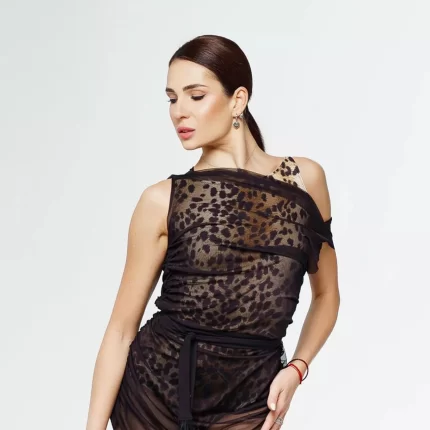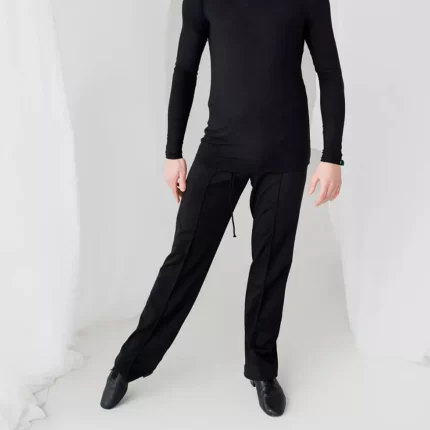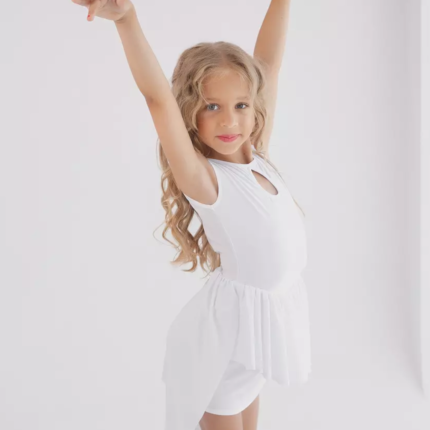Table of Contents
Introduction
Latin America, a vibrant tapestry of cultures, rhythms, and traditions, pulsates with a unique energy that finds its most expressive outlet in dance. And at the heart of this vibrant expression lies the captivating world of Latin American dresses. These garments are more than just clothing; they are a celebration of heritage, a testament to the enduring power of cultural fusion, and a visual embodiment of the passion and joy that define Latin dance. From the intricate patterns inspired by indigenous artistry to the flowing silhouettes that echo European elegance and the vibrant colors that reflect African rhythms, Latin dance dresses tell a story of a rich and complex cultural heritage. This article delves into the fascinating roots of these garments, exploring the diverse influences that have shaped their evolution and celebrating the enduring legacy of Latin American culture in the world of dance and fashion.
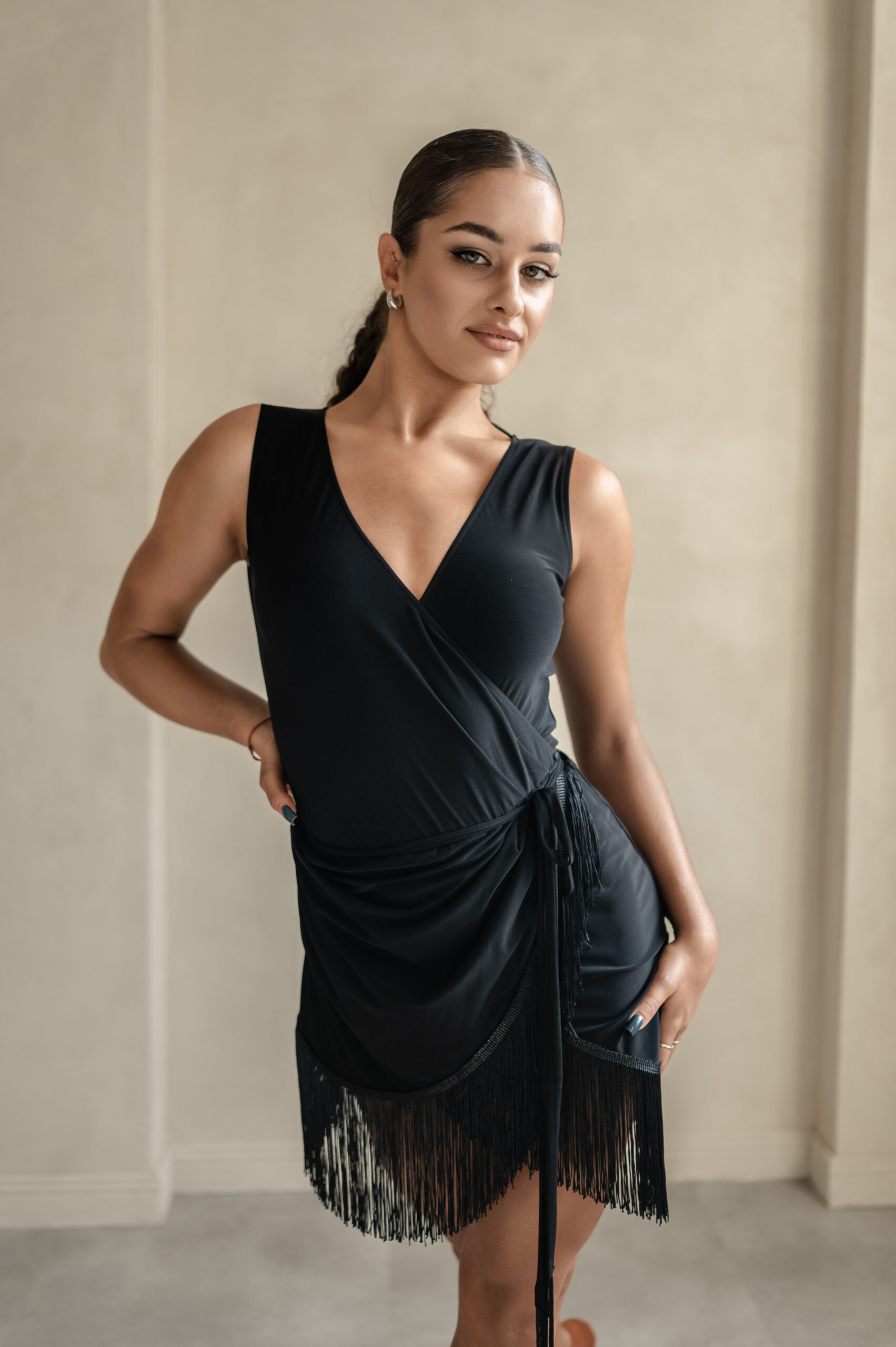
I. The Roots of Latin Dance Costumes
The captivating designs of Latin dance costumes are not simply the product of artistic imagination; they are deeply rooted in the rich and diverse history of Latin America. To understand the vibrant colors, the flowing fabrics, and the intricate details, we must journey back in time and explore the cultural forces that have shaped these iconic garments. This section delves into the foundational influences that have given rise to the Latin dance dresses we see today, tracing the threads of indigenous traditions, Spanish and European aesthetics, and the vibrant pulse of African heritage. Let’s uncover the fascinating stories woven into every ruffle, sequin, and stitch.
1.1 Influence of Indigenous Cultures
Long before the arrival of Europeans, the vibrant cultures of indigenous peoples flourished across Latin America. Their unique artistry, intricate textiles, and deep connection to the natural world laid the foundation for many aspects of Latin American culture, including fashion and dance. The influence of indigenous cultures can be seen in the vibrant colors, intricate patterns, and natural materials often found in traditional Latin American clothing.
For example, the bright reds, yellows, and blues seen in many traditional Latin American dresses often echo the natural dyes derived from plants, insects, and minerals used by indigenous artisans. Intricate weaving techniques, passed down through generations, produced elaborate patterns that often held symbolic meaning, representing elements of nature, cosmology, or tribal affiliation. Think of the geometric patterns of the Mayan huipil or the vibrant, bird-inspired designs of the Andean cultures.
These traditional garments, often worn during ceremonies and celebrations, were not just clothing; they were a form of cultural expression, reflecting the wearer’s identity, social status, and connection to their heritage. It is not hard to see how these elements found their way into early forms of Latin dance and, consequently, into the Latin dance costumes that evolved alongside them. The legacy of these indigenous traditions continues to inspire and influence Latin American fashion and dancewear to this day.
1.2 Spanish and European Influences
The arrival of Spanish conquistadors and other European colonizers in Latin America marked a significant turning point in the evolution of fashion and dance. Spanish influences, in particular, had a profound impact on the styles of clothing and dance that developed in the region. The introduction of new fabrics, silhouettes, and embellishments dramatically altered the landscape of Latin American fashion.
Think of the voluminous skirts, fitted bodices, and elaborate lace details often seen in traditional Spanish dress. These elements were gradually incorporated into the clothing of the colonized peoples, blending with existing indigenous styles to create new, hybrid forms of dress. The use of ruffles, for example, a hallmark of Spanish fashion, became a prominent feature in many Latin American dresses, adding a touch of drama and flair that perfectly complemented the developing dance styles.
European influences extended beyond Spain, with French and Portuguese styles also contributing to the evolving fashion landscape. The introduction of new materials like silk and velvet, along with European tailoring techniques, further transformed Latin American clothing, leading to the development of more structured and elaborate garments.
These colonial influences were not simply imposed upon the existing cultures; they were adapted, reinterpreted, and blended with indigenous and African traditions, creating the unique and vibrant tapestry of styles that characterize Latin American fashion and dance today. The legacy of this cultural fusion is evident in the Latin dance dresses we see on the dance floor, a beautiful testament to the complex history of the region.
1.3 African Influences
The transatlantic slave trade brought millions of Africans to Latin America, forcibly transplanting them to a new world. Despite the brutal conditions of slavery, they carried with them their rich cultural traditions, including music, dance, and fashion. African influences have had a profound and lasting impact on Latin American culture, perhaps most notably in the realm of music and dance.
The rhythms and movements of African dance traditions, deeply rooted in spirituality and community, blended with existing indigenous and European forms, giving rise to new, uniquely Latin American dance styles. This fusion is evident in the rhythmic complexity of dances like the samba, the rumba, and the cumbia, all of which bear the unmistakable imprint of African musical and dance traditions.
Afro-Latin culture also made significant contributions to fashion. The vibrant colors and bold patterns found in many Latin American dresses often echo the aesthetic traditions of West Africa. Think of the bright, geometric patterns of Kente cloth or the vibrant, tie-dyed fabrics of Nigeria. These influences can be seen in the use of bold color combinations, intricate beading, and the incorporation of natural materials like shells and feathers into dance costumes.
Furthermore, the emphasis on movement and rhythm in African dance traditions strongly influenced the design of Latin dance dresses. The need for freedom of movement, particularly in the hips and legs, led to the development of dress styles that emphasized fluidity and flexibility. The legacy of African culture is an integral part of the vibrant tapestry of Latin American identity, and its influence on dance and fashion continues to be celebrated and expressed today. The very soul of many Latin dance dresses are infused with African heritage through rhythm and movement.
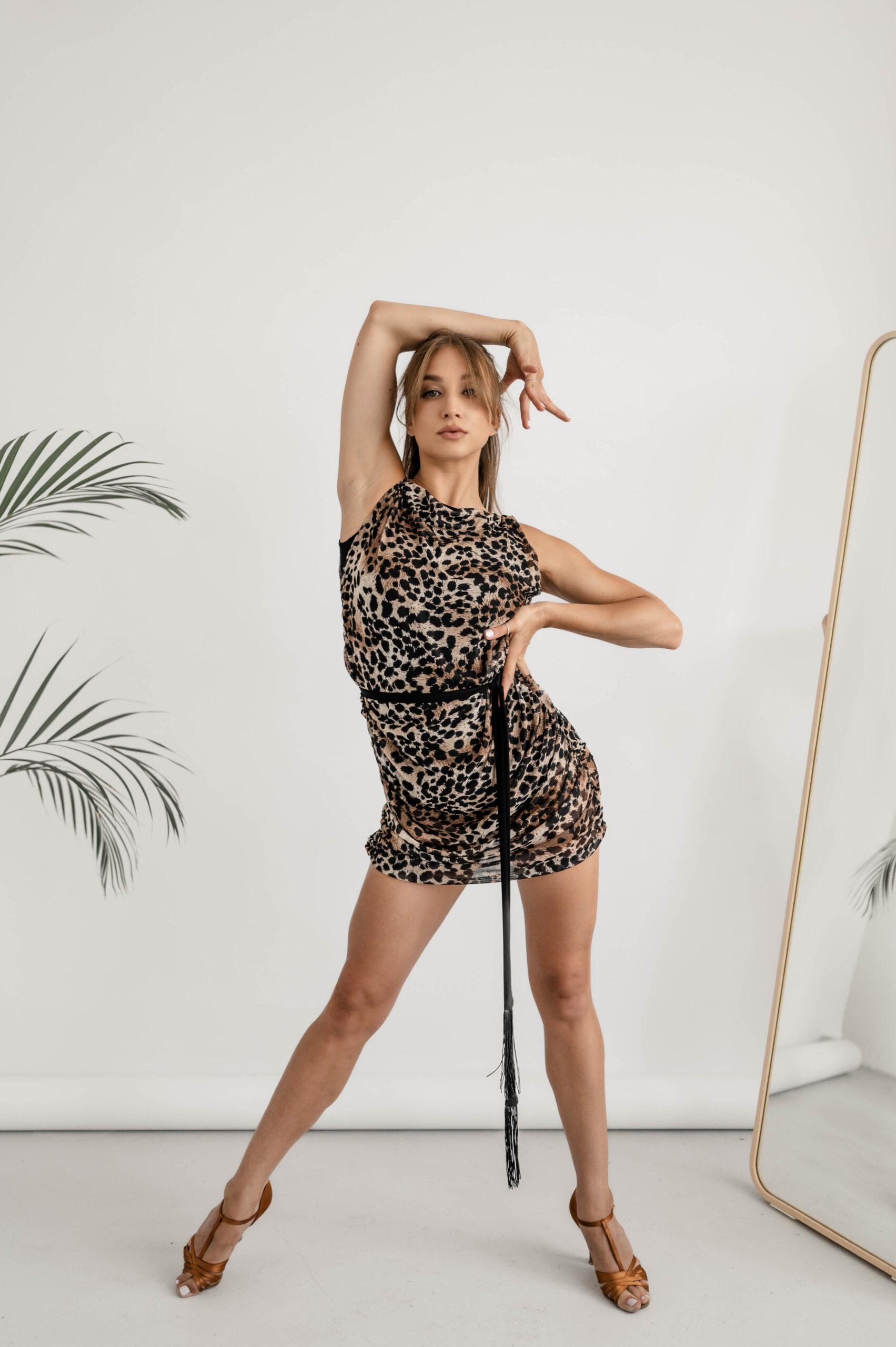
II. Evolution of Latin Dance Dresses
The Latin dance dresses we see today are not static relics of the past; they are the vibrant culmination of a dynamic and ongoing evolution. From their roots in the traditional clothing of indigenous, African, and European cultures, these garments have transformed over time, adapting to new social contexts, incorporating new materials and technologies, and reflecting the ever-changing rhythms of Latin dance itself. This section explores the fascinating journey of Latin dance dresses from their traditional origins to the dazzling modern designs we see on the dance floor today. We’ll examine how these dresses have evolved alongside the dances they accompany, reflecting the cultural shifts and artistic innovations that have shaped Latin American culture over centuries.
2.1 From Traditional to Modern
The journey from traditional Latin dresses to the modern Latin dresses we see today is a captivating story of cultural exchange, adaptation, and innovation. In the early days, dance costumes were often adapted from everyday clothing, reflecting the styles and traditions of the specific region and community. These traditional Latin dresses were typically made from natural fibers, adorned with handcrafted embellishments, and designed to allow for ease of movement during social dances and celebrations.
As Latin dances gained popularity and moved from social gatherings to the stage and competitive arenas, the dresses evolved to meet the demands of performance. New materials, like synthetic fabrics and sequins, were introduced, offering greater durability, flexibility, and visual impact. Silhouettes became more varied, with shorter hemlines, form-fitting bodices, and dramatic details like fringe and ruffles becoming increasingly popular.
The rise of professional dance and the influence of Hollywood films in the mid-20th century further accelerated the evolution of modern Latin dresses. Dance costumes became more glamorous and theatrical, designed to catch the eye and enhance the performance. The introduction of stretch fabrics revolutionized dancewear, allowing for greater freedom of movement and creating new possibilities for design.
Today, modern Latin dresses are a fusion of tradition and innovation, incorporating elements of historical styles while embracing contemporary design aesthetics and performance fabrics. They reflect the dynamic nature of Latin dance itself, constantly evolving and pushing the boundaries of creativity while honoring the rich cultural heritage from which they emerged.
2.2 Regional Variations
Latin America is a vast and diverse region, encompassing a multitude of cultures, each with its own unique traditions and artistic expressions. This incredible cultural diversity is beautifully reflected in the regional variations of Latin American dress styles, including dance costumes. From the vibrant carnival costumes of Brazil to the elegant guayaberas of Cuba and the intricate polleras of Panama, each region boasts its own distinct aesthetic, shaped by its unique history and cultural influences.
- Cuba: Cuban dance styles, like the rumba and the mambo, are often associated with flowing dresses, often featuring ruffles and vibrant colors that reflect the island’s vibrant culture. The bata cubana, a ruffled dress with origins in Afro-Cuban traditions, is a prime example of a uniquely Cuban contribution to Latin dancewear.
- Brazil: Brazilian samba, with its energetic rhythms and rapid hip movements, is synonymous with vibrant, often revealing, costumes adorned with feathers, sequins, and beads. These costumes reflect the exuberance and spectacle of Carnival, a central element of Brazilian culture.
- Argentina: Argentine tango, known for its passionate and intimate movements, is often accompanied by more elegant and sophisticated attire. Think sleek silhouettes, dark colors, and subtle embellishments that reflect the dance’s dramatic intensity.
- Mexico: Mexican folklorico dance encompasses a wide range of regional styles, each with its own distinctive costumes. From the colorful, embroidered dresses of Jalisco to the flowing skirts and blouses of Veracruz, these garments reflect the rich cultural heritage of Mexico’s diverse regions.
These are just a few examples of the many regional variations in Latin American dress styles. Exploring these variations reveals the depth and richness of Latin American culture and highlights the unique beauty of each region’s artistic traditions. These diverse styles continue to inspire and influence Latin dance dresses today, contributing to the vibrant and ever-evolving world of Latin dance fashion.
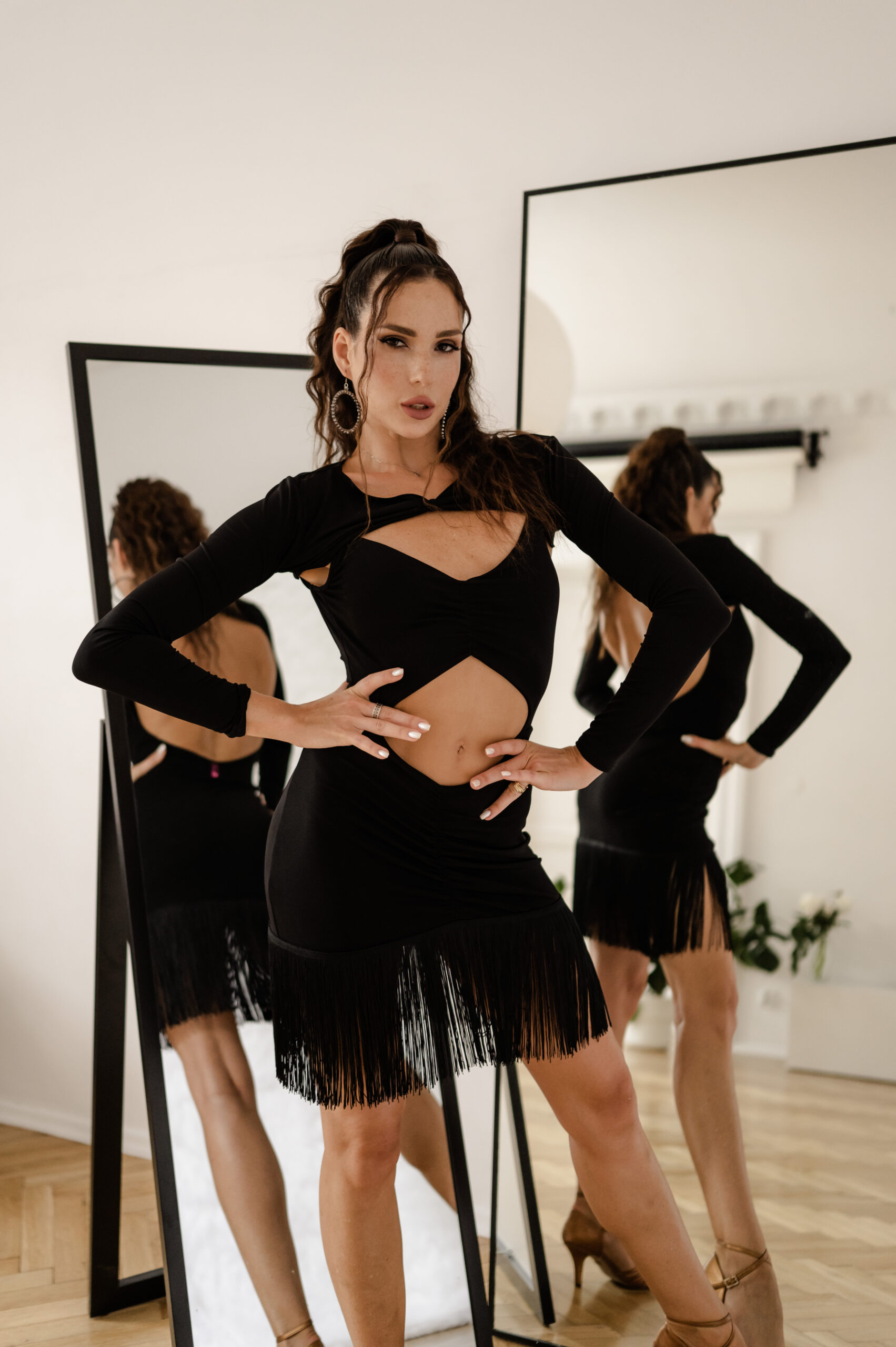
III. Fashion Dance: Honoring Tradition and Innovation
In the vibrant world of Latin dancewear, Fashion Dance stands as a brand that gracefully bridges the past and the present. We are deeply inspired by the rich cultural heritage of Latin America, and we strive to honor the traditions that have shaped Latin dance dresses for centuries. At the same time, we embrace innovation, incorporating modern design aesthetics and performance fabrics to create dresses that meet the needs of today’s dancers. This section explores how Fashion Dance weaves together cultural inspiration with contemporary design, creating Latin dancewear that is both authentic and cutting-edge. We believe in celebrating tradition while pushing the boundaries of creativity, offering dancers a unique blend of heritage and modernity.
3.1 Cultural Inspiration
At Fashion Dance, we believe that Latin dancewear is more than just clothing; it’s a celebration of culture, a tribute to tradition, and a powerful form of self-expression. Our design philosophy is deeply rooted in the rich cultural heritage of Latin America. We draw cultural inspiration from the vibrant colors, intricate patterns, and flowing silhouettes that have characterized Latin American dresses for centuries.
Our designers immerse themselves in the history and artistry of different Latin American regions, studying traditional garments, indigenous textiles, and the evolution of dance costumes over time. We’re inspired by the vibrant colors of Mexican folklorico dresses, the elegant lines of Argentine tango attire, the playful ruffles of Cuban rumba dresses, and the dazzling embellishments of Brazilian samba costumes.
This cultural inspiration is not about mere imitation; it’s about understanding the essence of these traditional styles and reinterpreting them in a way that is both authentic and contemporary. We strive to capture the spirit of Latin American culture in our designs, creating Latin dancewear that honors the past while embracing the dynamism of the present. When you wear a Fashion Dance dress, you’re not just wearing a beautiful garment; you’re wearing a piece of history, a celebration of culture, and a testament to the enduring power of dance.
3.2 Authenticity and Respect
At Fashion Dance, we’re passionate about creating Latin dancewear that is both beautiful and meaningful. We understand that we’re drawing inspiration from a rich cultural heritage, and we take our responsibility to honor that heritage seriously. Authenticity and respect are at the core of our design philosophy.
We’re committed to cultural sensitivity in every aspect of our work. This means that we don’t simply copy traditional designs; we study them, we learn about their origins and significance, and we strive to reinterpret them in a way that is both respectful and innovative. We avoid appropriating cultural elements in a way that is superficial or disrespectful, and we always strive to acknowledge the origins of our inspiration.
Our commitment to ethical fashion extends beyond design. We work with skilled artisans who are fairly compensated for their work, and we source our materials responsibly. We believe that creating beautiful Latin dancewear shouldn’t come at the expense of people or the planet.
When you choose a Fashion Dance dress, you can be confident that you’re wearing a garment that has been created with care, respect, and a deep appreciation for the cultural heritage that inspired it. We believe that authentic designs are not just about aesthetics; they’re about honoring the traditions and the people who created them.
3.3 Modern Silhouettes for Today’s Dancer
While we deeply respect and draw inspiration from tradition, Fashion Dance is also committed to innovation. We understand that today’s Latin dancers need modern Latin dresses that not only look beautiful but also perform flawlessly on the dance floor. That’s why we blend traditional elements with contemporary dancewear design principles and cutting-edge performance fabrics.
Our designers are constantly exploring new silhouettes, experimenting with new materials, and pushing the boundaries of creativity to create Latin dancewear that is both stylish and functional. We incorporate modern design elements like asymmetrical cuts, illusion panels, and innovative embellishment techniques to create dresses that are both visually stunning and performance-ready.
We also utilize the latest in performance fabrics. These fabrics offer superior stretch, breathability, and moisture-wicking properties, ensuring that dancers stay comfortable and confident even during the most demanding routines. We understand that dancers need to move freely and expressively, and our dresses are designed to support their every move.
At Fashion Dance, we believe that tradition and innovation can go hand in hand. We’re proud to offer modern Latin dresses that honor the rich cultural heritage of Latin America while meeting the needs of today’s dancers. We’re passionate about creating dancewear that empowers dancers to express themselves fully and confidently, both on and off the dance floor.
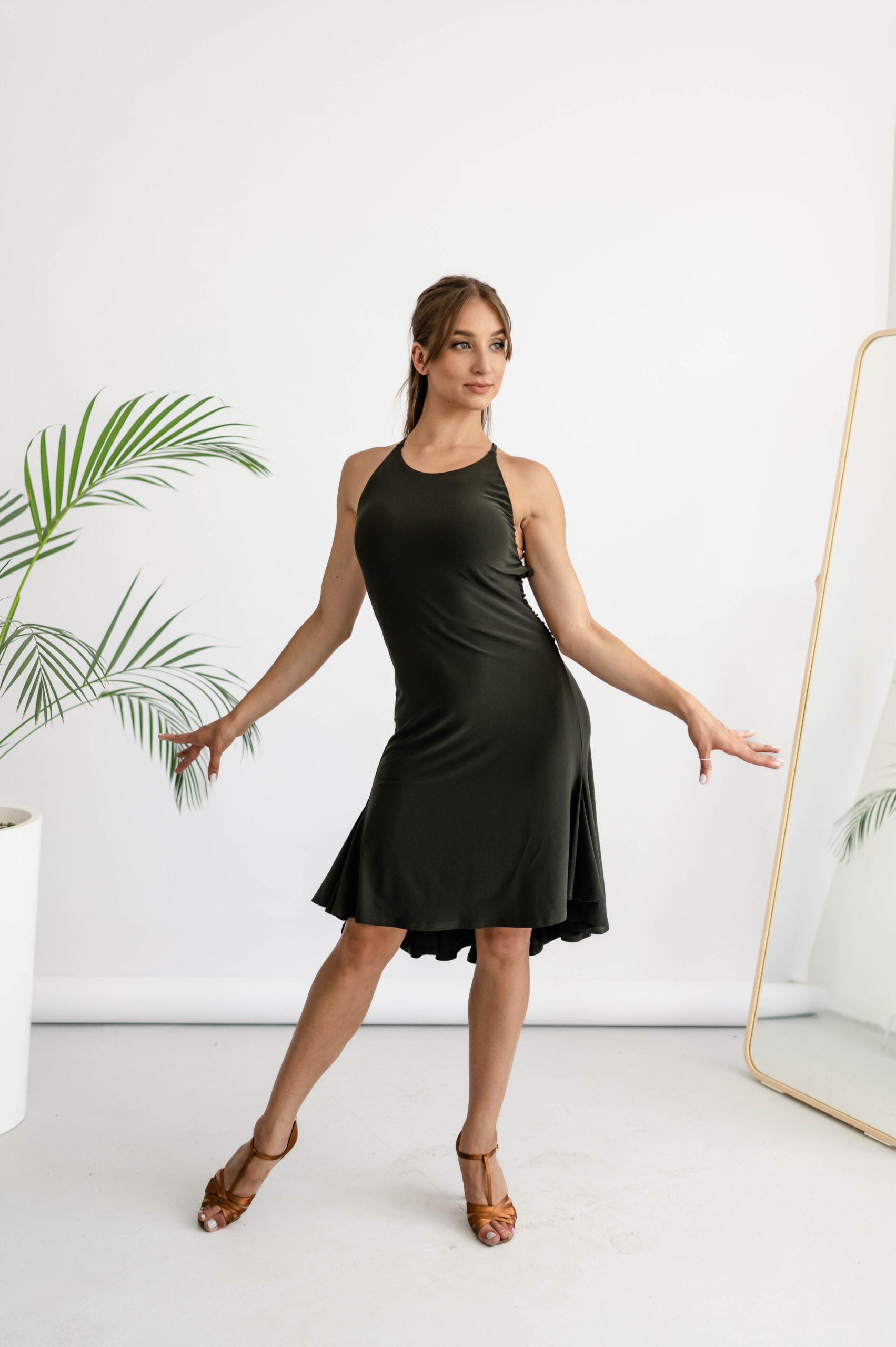
IV. Key Features of Latin American Dresses
Latin American dresses are renowned for their vibrant energy, expressive designs, and captivating details. They are a feast for the eyes, reflecting the passion, joy, and cultural richness of Latin America. This section delves into the key features that define these iconic garments, exploring the elements that make them so unique and so perfectly suited for the dynamism of Latin dance. From the bold use of color and pattern to the movement-enhancing designs and intricate embellishments, we’ll uncover the secrets behind the allure of Latin American dresses.
4.1 Vibrant Colors and Patterns
One of the most striking features of Latin American dresses is their bold and exuberant use of color and pattern. These dresses are a riot of vibrant hues, reflecting the energy, passion, and joy that are so characteristic of Latin American culture. From the fiery reds and oranges that evoke the heat of the sun to the deep blues and greens that reflect the lush landscapes, the color palettes of these garments are a visual celebration of life.
Vibrant colors are not just aesthetically pleasing; they also hold cultural significance. In many Latin American cultures, specific colors are associated with particular meanings, emotions, or even deities. For example, red might symbolize passion and love, while yellow might represent joy and prosperity.
Bold patterns are another defining feature of Latin American dresses. These patterns often draw inspiration from indigenous textiles, incorporating geometric designs, floral motifs, and intricate abstract patterns that have been passed down through generations. Think of the vibrant stripes of a Mexican sarape, the ntricate floral embroidery of a Panamanian pollera, or the bold geometric patterns of a Mayan huipil.
These vibrant colors and bold patterns are not just decorative; they’re an integral part of the cultural expression that defines Latin American identity. They’re a visual representation of the region’s rich history, its diverse cultural influences, and its vibrant spirit. They are also a key element of many Latin dances. You can read more about it in this article: Latin Dance Dresses: A Guide to Choosing the Right Style and Fit
4.2 Movement-Enhancing Designs
Latin American dresses are not just about looking beautiful; they’re about moving beautifully. The dances of Latin America are known for their fluidity, rhythm, and expressiveness, and the dresses are designed to enhance these movements, creating a captivating visual spectacle on the dance floor. Movement in dance is key, and these dresses are designed to amplify it.
Fringe, for example, is a popular element in many Latin dance dresses. As the dancer moves, the fringe sways and shimmers, accentuating the rhythm and creating a dynamic visual effect. Imagine the fringe on a salsa dress swaying with every hip movement, or the long fringe on a samba costume creating a blur of motion as the dancer spins.
Ruffles are another key design element that enhances movement. Whether it’s a cascade of ruffles on a flamenco skirt or a delicate ruffle trim on a rumba dress, these details add volume and texture, creating a sense of fluidity and grace. Picture a dancer twirling in a dress with a ruffled skirt, the fabric billowing and swirling around them like a living sculpture.
Flowing fabrics like chiffon, silk, and georgette are also essential for creating movement-enhancing designs. These fabrics drape beautifully and move with the dancer, creating a sense of effortless elegance. Imagine a tango dancer gliding across the floor, the flowing fabric of their dress trailing behind them like a whisper.
At Fashion Dance, we understand the importance of movement in Latin dance. Our dresses are designed to enhance the dancer’s movements, creating a visual spectacle that is both captivating and expressive. We use fringe, ruffles, and flowing fabrics strategically, ensuring that every dress is not only beautiful but also functional, allowing dancers to move with freedom, grace, and confidence. Now, let’s explore the final touches: embellishments!
4.3 Embellishments and Details
Latin American dresses are often adorned with intricate embellishments and details that add a touch of sparkle, glamour, and cultural richness. These embellishments are not just decorative; they often hold symbolic meaning, reflect the artistry of different cultures, and enhance the overall visual impact of the dress.
Sequins and beads are commonly used to add sparkle and dimension to Latin American dresses. Imagine the way sequins catch the light as a dancer twirls, creating a dazzling display of shimmer and shine. Beads, often arranged in intricate patterns, add texture and depth to the fabric, reflecting the meticulous craftsmanship that goes into creating these garments.
Embroidery is another important embellishment technique, particularly in traditional Latin American clothing. Intricate floral patterns, geometric designs, and symbolic motifs are often embroidered onto dresses, reflecting the cultural heritage of different regions. Think of the colorful embroidery on a Mexican folklorico dress or the delicate gold thread work on a Panamanian pollera.
Other embellishments might include lace, ribbons, appliques, and even natural elements like shells or feathers, depending on the specific style and cultural origin of the dress. These details add a unique touch of personality and artistry, transforming a simple dress into a work of art.
At Fashion Dance, we’re passionate about incorporating these intricate details into our designs. We believe that embellishments are more than just decoration; they’re an opportunity to tell a story, to celebrate cultural heritage, and to enhance the beauty and expressiveness of our Latin dance dresses. We carefully select our embellishments, ensuring they are not only visually stunning but also durable enough to withstand the rigors of dance.
Conclusion
Latin American dresses are more than just garments; they are vibrant expressions of a rich cultural heritage, a testament to the enduring power of tradition, and a celebration of the joy and passion that define Latin dance. From their roots in the artistry of indigenous cultures, the elegance of European fashion, and the rhythmic pulse of African traditions, these dresses have evolved into the captivating creations we see today. They are a vibrant fusion of diverse influences, a reflection of the dynamic history and cultural tapestry of Latin America.
The bold colors, intricate patterns, movement-enhancing designs, and exquisite embellishments all contribute to the unique allure of Latin American dresses. They are a visual feast, embodying the energy, passion, and artistry of Latin dance. Whether it’s the playful sway of fringe on a salsa dress, the elegant drape of a tango gown, or the vibrant colors of a samba costume, these dresses tell a story, evoke a mood, and invite us to celebrate the beauty and diversity of Latin American culture. They are a reminder that clothing can be more than just functional; it can be a form of art, a cultural statement, and a powerful tool for self-expression. Through these beautiful garments, the spirit of Latin America continues to dance its way into our hearts.
How do modern Latin dance dresses incorporate elements of traditional clothing while still being functional for dance?
Modern Latin dance dresses often pay homage to traditional garments through the use of vibrant color palettes, symbolic patterns, and specific design elements like ruffles or fringe. Designers might draw inspiration from the bright hues found in indigenous textiles, incorporating them into contemporary silhouettes. Traditional embroidery patterns might be reimagined using sequins or beads, adding sparkle and texture while referencing historical artistry. Ruffles, a feature in many traditional Latin American and Spanish dresses, are often incorporated to enhance movement and create a dynamic visual effect on the dance floor. The key is to adapt these traditional elements to meet the functional needs of dancers. This means using modern, lightweight, and stretch fabrics that allow for a full range of motion.
Silhouettes are often streamlined for ease of movement, and embellishments are strategically placed to enhance, not hinder, the dancer’s performance. For instance, a traditional full, ruffled skirt might be adapted into a shorter, more manageable length for quick turns and intricate footwork. A traditional embroidered pattern might be recreated with lightweight sequins to add sparkle without adding excessive weight or restricting movement. Designers might also incorporate modern cuts and silhouettes, such as asymmetrical designs or open backs, to add a contemporary touch while maintaining a connection to the cultural roots of the garments. The goal is to find a balance between honoring tradition and creating a garment that is both beautiful and practical for the demands of modern Latin dance.
What are some ethical considerations when purchasing Latin American-inspired dresses?
When purchasing Latin American-inspired dresses, it’s important to be mindful of ethical considerations, particularly regarding cultural appropriation, fair labor practices, and sustainability. Cultural appropriation occurs when elements of a minority culture are adopted by members of a dominant culture, often without understanding or respecting their original context or significance. To avoid this, it’s crucial to research the origins of the design elements and to purchase from designers or brands that demonstrate a genuine understanding and appreciation of the cultures they are drawing inspiration from. Look for designers who collaborate with artisans from the cultures they are inspired by, ensuring that the designs are created with respect and that the artisans are fairly compensated for their work.
Fair labor practices are another crucial consideration. The fashion industry has a history of exploiting workers, particularly in developing countries. When purchasing Latin American-inspired dresses, inquire about the working conditions of the people who made the garments. Look for brands that are transparent about their supply chains and that prioritize fair wages, safe working conditions, and ethical treatment of their employees. Certifications like Fair Trade can provide some assurance that these standards are being met.
Sustainability is also an important factor to consider. The fashion industry is a major contributor to pollution and waste. When purchasing Latin American-inspired dresses, look for brands that use sustainable materials, such as organic cotton, Tencel, or recycled fabrics. Consider the environmental impact of the production process, including the use of water, energy, and chemicals. Supporting brands that prioritize sustainable practices helps to minimize the negative environmental impact of your purchase.
Finally, consider supporting artisans and designers from the cultures that inspire the designs. By purchasing directly from Latin American artisans or from brands that collaborate with them, you can help to ensure that the economic benefits of your purchase go directly to the communities that created these beautiful traditions. This also helps to preserve traditional craftsmanship and cultural heritage. By being mindful of these ethical considerations, you can make informed purchasing decisions that are both stylish and responsible, contributing to a more equitable and sustainable fashion industry.
How can I style a Latin American dress for a non-dance event?
Latin American dresses, with their vibrant colors, bold patterns, and flattering silhouettes, can be surprisingly versatile for non-dance occasions. The key is to adapt the styling to suit the specific event and your personal style. For a daytime event, consider a more casual approach. A floral-print sundress inspired by Mexican or Cuban styles can be paired with flat sandals or espadrilles, a denim jacket, and a straw hat for a relaxed, bohemian look. You could also choose a dress with a more subtle print or a solid color and accessorize with a colorful scarf or statement jewelry.
For an evening event, you can elevate the look with more sophisticated accessories. A vibrant, form-fitting dress inspired by the tango or salsa can be paired with elegant heels, a clutch, and statement earrings. Consider a dress with subtle embellishments, like beading or lace, for a touch of glamour. A solid-colored dress in a rich jewel tone, such as emerald green or sapphire blue, can be particularly striking.
You can also incorporate elements of Latin American style into your everyday wardrobe. A ruffled top, inspired by flamenco or rumba dresses, can be paired with jeans or a skirt for a touch of feminine flair. A brightly colored or embroidered blouse can add a pop of color and cultural richness to a simple outfit. Accessorize with handcrafted jewelry from Latin American artisans to complete the look.
When styling a Latin American dress for a non-dance event, consider the level of formality, the time of day, and the overall aesthetic you want to achieve. Don’t be afraid to experiment with different accessories and styling techniques to create a look that is both stylish and respectful of the cultural origins of the dress. The goal is to adapt the vibrant spirit of Latin American fashion to suit your personal style and the specific occasion, creating a unique and memorable outfit.
How has the rise of social media impacted the popularity and evolution of Latin dance and its associated fashion?
Social media has had a profound impact on the popularity and evolution of Latin dance and its associated fashion. Platforms like Instagram, TikTok, and YouTube have provided a global stage for dancers, choreographers, and fashion designers to showcase their talents and creativity, reaching audiences far beyond their local communities.
Firstly, social media has democratized access to Latin dance. Aspiring dancers worldwide can now learn from renowned instructors through online tutorials and classes, regardless of their geographical location. This has led to a surge in interest and participation in Latin dance globally, fostering a greater appreciation for its diverse styles and cultural richness.
Secondly, social media has created a vibrant online community of Latin dance enthusiasts. Dancers can connect with each other, share their progress, and find inspiration from their peers. This sense of community has helped to fuel the growth and evolution of Latin dance, as dancers are constantly exposed to new ideas, styles, and interpretations.
Thirdly, social media has significantly impacted Latin dance fashion. Dancers can now showcase their outfits to a global audience, creating trends and influencing purchasing decisions. Designers and brands specializing in Latin dancewear have gained visibility and reach, allowing them to connect directly with their target audience. This has led to a greater demand for stylish and functional dancewear, as dancers seek outfits that not only look good but also enhance their performance and reflect their personal style.
Furthermore, social media has accelerated the fusion of styles and the evolution of Latin dance fashion. Dancers are exposed to a wider range of influences, both traditional and contemporary, leading to creative experimentation and the blending of different aesthetics. This has resulted in a more diverse and dynamic fashion landscape within the Latin dance world.
Social media platforms have also become a powerful tool for marketing and branding. Dance schools, instructors, and performers use these platforms to promote their services, events, and merchandise. This has created new opportunities for those involved in the Latin dance industry, allowing them to build their brands and reach wider audiences.
However, the rise of social media also presents some challenges. The focus on visual appeal and the pressure to create viral content can sometimes overshadow the artistry and authenticity of Latin dance. It’s important to remember that social media is just one aspect of the larger dance world and that it should not replace genuine connection, in-person learning, and respect for the cultural roots of Latin dance.
In conclusion, social media has undeniably transformed the landscape of Latin dance and its associated fashion. It has democratized access, fostered a global community, accelerated the evolution of styles, and created new opportunities for dancers and designers. As social media continues to evolve, it will undoubtedly continue to shape the future of Latin dance and fashion in exciting and unpredictable ways.
What is the significance of specific colors in Latin American dresses?
Colors in Latin American dresses are not just aesthetically pleasing; they often carry deep cultural and symbolic meanings. These meanings can vary across different regions and indigenous groups, but some common associations include:
Red: Often associated with passion, love, life, and energy. It’s a powerful color frequently seen in dances like the tango and salsa, reflecting the intensity and emotion of these styles. In some cultures, it also symbolizes war or sacrifice.
Yellow: Represents joy, happiness, the sun, and prosperity. It’s a vibrant color that evokes a sense of optimism and celebration, often seen in festive dances like the merengue and cumbia. In certain cultures it is also associated with the deity of sun.
Blue: Can symbolize the sky, water, and tranquility. In some indigenous cultures, it’s associated with spirituality and protection. Lighter shades might represent peace, while darker shades can signify depth and mystery.
Green: Often connected to nature, growth, fertility, and hope. It can be seen in dances that celebrate the harvest or that have connections to the natural world. In some cultures, it also holds healing powers.
Orange: A vibrant color associated with energy, enthusiasm, and creativity. It can also represent the harvest and abundance.
Purple: Often associated with royalty, spirituality, and magic. In some cultures, it’s also linked to mourning or penitence.
White: Can symbolize purity, peace, and spirituality. It’s often seen in religious ceremonies and can also represent new beginnings.
Black: While in Western cultures it’s associated with mourning, in some Latin American cultures, black can represent elegance, power, and formality. It’s a prominent color in the Argentine tango, reflecting the dance’s dramatic intensity.
It’s important to remember that these are just some general associations, and the specific meanings of colors can vary greatly depending on the cultural context. The vibrant colors in Latin American dresses are often derived from natural dyes, further connecting them to the land and indigenous traditions. The use of these colors in dance costumes is not just about visual appeal; it’s a way of honoring cultural heritage, expressing emotions, and connecting with the deeper meanings embedded in the dances themselves. The specific colors in a dress might also reflect the region of origin, the specific dance being performed, or the story being told through the dance.

